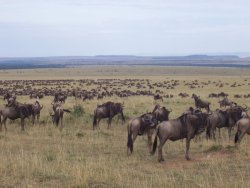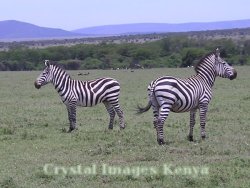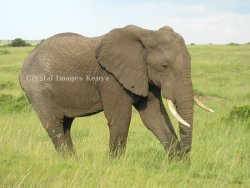TOURISM IN KENYA
Great Rift Valley
Beautiful
countryside
Hotels
& Lodges
Kenya's
Coast
Economy
Government
Kenya
National
Parks
Lake
Victoria
The
People of Kenya
Wildlife >

Wildebeest herds in the Maasai Mara.



Lion resting after a meal. The Kenya government
uses the lion as its symbol.

LINKS
|
Wildlife in Kenya
A wide range of wildlife species can
be found within Kenya's borders all appearing in a multitude of sizes,
shapes, colors and temperaments. Its almost impossible to see all these
during the course of a single visit, though lots of people have lots of
fun trying to accomplish this feat!
Beginning with the
monstrous elephant roaming the plains and forests, to the regal lion
whose roar can send lesser creatures cowing in fear over a radius of
several kilometres. At the opposite end of the animal spectrum are rare
insects which only exist on specific forests within Kenya - and no
where else on earth.
The land of Kenya has been famed
for its wildlife long before the birth of the modern state. When Arab
explorers came across the giraffe thousands of years ago, they named it
"giraffa" meaning "fast camel". When Chinese sailors visited the East
Africa coast in the Middle Ages, they took with them a shipload of
herbivorous animals to show the peculiarities of the land they had
encountered across the vast seas.
Wildlife has thrived in this part of
the world thanks to the savannah type of vegetation growing in a
climate that rarely experiences extremes. Until a century ago, the
human population was extremely low compared to the land area and this
allowed wildlife to flourish virtually undisturbed. Many African tribes
discouraged the hunting of wild animals for food and this contributed
to their continued existence to this day. The Maasai thought that a
responsible man should feed his family from his herds of livestock
hence anyone hunting wild game was assumed too lazy to raise cattle.
The massive numbers of wildlife at
the beginning of the 20th century attracted rich, famous personalities
from all over the world eager to collect hunting trophies from what was
then frontier country. Its said that herds of buffalo and rhino were
walking along the dusty streets of Nairobi in the early 1900s. Of
course that's no longer the case, but there's still lots of wild game
around the country to satisfy your curiosity. Only this time, hunting
is strictly forbidden by law. Beware: possession of game trophies such
as skins and horns is strictly regulated.
The lion is said to be King of the jungle probably because of its mane.
In reality, few wild lions actually keep a mane because fur gets lost
to the
bush and grass. The lion is a big cat that has evoked fear and
respect since time immemorial. The roar of a lion after a hearty
meal in the growing shadows of the setting sun is a sound that sends
shivers through any living creature within earshot. The Maasai
tribe encouraged its young men to kill lions in order to graduate into
the privileged class of warriors but back then, it was done in a
sustainable manner. In modern times, the lion is the mascot of the
Kenya government, and its image adorns the national Coat of Arms.
Other big cats that can easily be seen in Kenya include the fast
running cheetah and the stealthy leopard. Smaller wild cats of various
species can be found in the wilderness.
Elephant can be found in most parts of Kenya, but is best seen in
national parks such as the Tsavo, Mt Kenya, Aberdares, Amboseli, Shaba,
Shimba Hills and many others. It thrives just as well in lush forest as
it does in woodland savannah. Its huge appetite shouldn’t be surprising
but it can traverse long distances quite first in search of food.
Elephant numbers are gradually increasing thanks to active conservation
measures taken by world governments after these mammals were almost
decimated by poachers in the 1980s. However, there is growing concern
with the rising cases of elephants destroying farmlands or causing
deaths as human settlements encroach on previously uninhabited areas.
The dilemma facing conservationists is how to balance the demands of
human development and the need to save the elephant.
Elephants have grown fearful of
man's presence and its
advisable to view them from a safe distance.
The African elephant can be found in our sun-drenched landscapes
grazing side by side with herbivores such as the striped zebra,
temperamental buffalo and the playful dik dik. Various species of
antelope and giraffe can be found right across the country. The
Biblical paradise, where all animals live harmoniously, finds easy
rendition right here on earth in Kenya, where animals of many species,
sizes and dispositions share grazing grounds and water. Carnivores such
as lions, leopards and hyenas only hunt and kill when hunger pangs
strike. Once they've eaten their fill, the herbivores can move safely
move around them without getting attacked.
Playful baboons and monkeys can be found all over our forests and
woodland plains. Monkeys and baboons are so prevalent that they are
regarded as pests by local farmers, since they eat anything which
humans consider edible including grains, fruits and vegetables. The
primates are quite capable of digging up potatoes and cassava, or
peeling oranges.
Traditionally, the black
and white fur coat of the colobus monkey was worn by revered chiefs and
medicine men. Several suburbs in our towns play host to some monkeys
and baboons that have adapted to scavenging and begging. Chimpanzees
are not naturally found in Kenya.
Zebra, buffalo and antelope species are highly intelligent in spite of
their appearance which is similar to that of donkeys, cows and goats
respectively. They possess strong senses of smell and hearing.
Diverse reptilian species can be found alongside the well known
mammals. Snakes may not be everybody’s favorite spectacle but those
interested in them will find enough to satisfy their appetites.
Pythons, mambas, vipers and adders have made their homes in the
country’s forest, deserts, marshes and sun-burnt rocks. A snake park is
in Nairobi for convenient viewing of the lithe creatures. Crocodiles
have populated the local rivers and some sections of lakes. The
concentration of crocodiles on Central Island of Lake Turkana is said
to be one of the highest in the world. Nevertheless, the local people
are, quite understandably, not very keen on the presence of these
fearsome animals for several people lose their lives each year to
crocodiles.
Birdwatchers and ornithologists (bird researchers) have found Kenya to
be a valuable destination as far as the range of bird species is
concerned. The world’s largest bird, the ostrich, is comfortable in our
climate and grasslands. Ostrich eggs are proving to be a new found
delicacy. Forest birds in Mt Kenya and Aberdare Ranges are in great
abundance. Vultures, whose work in nature is to clean up carcasses, can
be found all over the wilderness. Eagles, hawks, crows, marabou storks,
swallows, weaver birds and many others can be seen in the towns too.
Pink colored flamingo have made their home on the Rift Valley lakes of
Nakuru and Elmenteita and so numerous are they that, from afar, the
lake shores seem painted in pink.
Back to top
|









